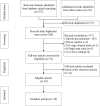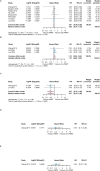Effect of post-mastectomy radiation therapy on survival in breast cancer with lymph nodes micrometastases: a meta-analysis and systematic review
- PMID: 40406246
- PMCID: PMC12094970
- DOI: 10.3389/fonc.2025.1489390
Effect of post-mastectomy radiation therapy on survival in breast cancer with lymph nodes micrometastases: a meta-analysis and systematic review
Abstract
Background: Axillary management of patients with early-stage breast cancer (ESBC) has evolved, especially with the implementation of precision radiotherapy techniques that have resulted in a significant reduction in treatment-related toxicities, but it is unclear whether post-mastectomy radiotherapy (PMRT) improves survival outcomes in breast cancer with lymph nodes micrometastases (BCLNMM, that is T0, T1 ~2NmiM0). Our study is to systematically evaluate the effect of PMRT on survival in breast cancer with lymph nodes micrometastases.
Methods: A literature search was performed for randomized controlled trials (RCTs) or retrospective studies related to PMRT versus non-post-mastectomy radiotherapy (non-PMRT) in the adjuvant treatment of ESBC in PubMed, Cochrane Library, Embase, CNKI and other databases. R package meta software was used to perform meta-analyses with hazard ratio (HR). Newcastle Ottawa scale was selected for quality assessment. The review was prospectively registered on PROSPERO (CRD42024562444).
Results: 10 relevant studies were screened, all of which were retrospective studies. The difference in overall survival (OS) was not statistically significant (HR = 0.92, 95%CI: 0.81 ~ 1.04; Z = 1.35, P = 0.177). The difference in breast cancer-specific survival (BCSS) between the PMRT group and the non-PMRT group was not statistically significant HR = 1.18, 95%CI: 0.94 ~ 1.48; Z = 1.41, P =0.160). The difference in disease-free survival (DFS) was statistically significant (HR = 0.47, 95%CI: 0.23 ~ 1.00; Z = 1.96, P =0.049). The difference in local recurrence free survival (LRRFS) was also not statistically significant (HR = 0.50, 95%CI: 0.11 ~ 2.26, P = 0.190). The difference in distant-metastasis free survival (DMFS) was not statistically significant (HR = 0.54, 95%CI: 0.22 ~ 1.35, P = 0.356).
Conclusions: Despite the tendency of PMRT in BCLNMM to improve DFS, OS, BCSS, LRRFS, and DMFS showed no benefit, therefore, PMRT should be used with caution in BCLNMM.
Systematic review registration: https://www.crd.york.ac.uk/prospero/, identifier CRD42024562444.
Keywords: axillary lymph node dissection; breast cancer; lymph nodal micrometastasis; meta-analysis; radiotherapy; sentinel lymph node biopsy.
Copyright © 2025 Zheng, Huang, Chen and Chen.
Conflict of interest statement
The authors declare that the research was conducted in the absence of any commercial or financial relationships that could be construed as a potential conflict of interest.
Figures




Similar articles
-
Post-mastectomy Radiation Therapy in Breast Cancer Patients with Nodal Micrometastases.Ann Surg Oncol. 2018 Sep;25(9):2620-2631. doi: 10.1245/s10434-018-6632-1. Epub 2018 Jul 9. Ann Surg Oncol. 2018. PMID: 29987606
-
Outcomes of Stage I and II Breast Cancer with Nodal Micrometastases Treated with Mastectomy without Axillary Therapy.Breast Cancer Res Treat. 2021 Oct;189(3):837-843. doi: 10.1007/s10549-021-06341-1. Epub 2021 Aug 3. Breast Cancer Res Treat. 2021. PMID: 34342766
-
Postmastectomy radiation therapy can improve survival for breast cancer patients with 1-3 positive axillary lymph nodes: a retrospective cohort study using the SEER database.Transl Cancer Res. 2021 May;10(5):1984-2001. doi: 10.21037/tcr-20-3337. Transl Cancer Res. 2021. PMID: 35116521 Free PMC article.
-
Efficacy and safety comparison between axillary lymph node dissection with no axillary surgery in patients with sentinel node-positive breast cancer: a systematic review and meta-analysis.BMC Surg. 2023 Jul 26;23(1):209. doi: 10.1186/s12893-023-02101-8. BMC Surg. 2023. PMID: 37495945 Free PMC article.
-
Does Post-Mastectomy Radiotherapy Confer Survival Benefits on Patients With 1-3 Clinically Positive Lymph Nodes Rendered Pathologically Negative After Neoadjuvant Systemic Chemotherapy: Consensus from A Pooled Analysis?Eur J Breast Health. 2024 Apr 1;20(2):81-88. doi: 10.4274/ejbh.galenos.2024.2023-12-14. eCollection 2024 Apr. Eur J Breast Health. 2024. PMID: 38571693 Free PMC article.
References
Publication types
LinkOut - more resources
Full Text Sources

